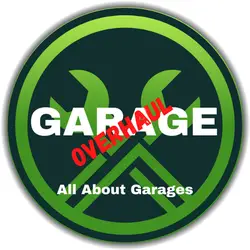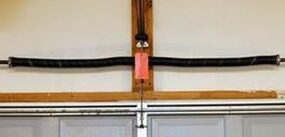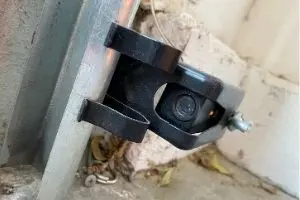How Garage Door Remote Works (Info& Troubleshooting)
This post contains affiliate links.
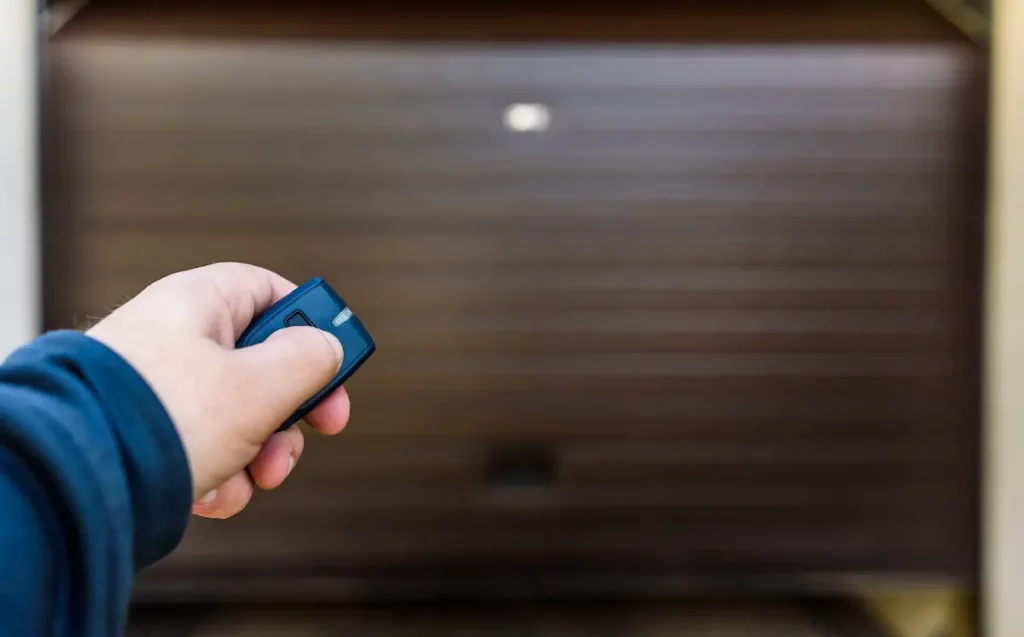
Ever wonder how the remote control for your garage door actually works?
Garage door remotes operate by sending a coded signal via radio to the motor, which then opens the garage door. The garage door only opens if the code in the signal matches the motor.
Aside from that, there are many more features too. Let’s explore some of the common questions about garage door remotes first. Then we look at how to fix it if the remote is not working.
The History of Garage Door Remotes
Wireless garage door openers were first invented in the US. The first controllers were very simple. In fact, it was so simple that a single controller could open nearby garage doors too.
Imagine if you and your neighbor Steve both have one of those. When Steve presses his garage remote, his door and yours open. As funny as that is, think about the problems that may come.
Later, garage door operators added simple codes and paired them with the doors. These are called fixed-code garage door opener remotes. The matching garage door would only open when the remote is pressed. This prevents a remote from opening nearby garage doors.
There are safety issues with these fixed-code garage door opener remotes as well. A hacker only needs to learn the code using a detector.
The hacker can then resend the same radio wave and trick the antenna radio receiver into thinking it’s from a remote control. The opener mechanism then works, opening the garage door and exposing your entire garage to the hacker.
Fortunately, things have evolved, and we have a much safer garage door opener technology today.
Modern systems use rolling/changing codes. Unlike simple codes, the rolling code changes when the door opens or closes. You also get many other security features with modern garage door systems.
Thanks to the rolling code method, it’s impossible for your transmitter to open another electric garage door or vice versa. In fact, more recent systems include more codes and longer codes.
Today, garage door opener technology is unbreakable to code hacking. The codes are long and change frequently, so hacking becomes quite impossible.
How Does A Garage Door Remote Work?
With a single button press, the electric garage door opens like a dream. But have you ever wondered how these garage remotes actually operate and work?
Inside your remote, there’s a radio transmitter. The radio transmitter communicates with the receiver in the garage door motor.
When you press the buttons on the garage door remote, a radio signal is sent from the remote to the opener/receiver. Most remotes use a specific frequency in the range of 300-400MHz. The radio signal also contains a code.
For security reasons, the codes that the remote and the receiver use to communicate change frequently. This system is called hopping/rolling code.
The codes are also longer. These codes are usually 40-bit, which means there are over a trillion possible combinations of codes.
Now imagine how hard that would be for a hacker to find.
Here’s how the whole process works:
- In your remote, a transmitter’s controller chip holds the current 40-bit code. The code is held in the controller’s memory chip.
- When you push a button on your controller fob, it sends that 40-bit code out, along with a function code that tells the door motor what to do (open the doors, close the doors.)
- Once the code is sent out from the remote, it generates a new random code.
- The receiver on the garage door motor receives the code and operates. It will also generate a new code, similar to the remote.
- This keeps the remote and garage door motor synchronized.
Can The Remote And Receiver Become Desynchronized?
Yes, it can happen. This can happen when you are far away from your garage or car and push the button on the transmitter. Since you are far away, the code from the remote does not reach the receiver on the motor.
This means the receiver still keeps the old code, while your remote has already generated a new one. The remote and the receiver are no longer synchronized.
The receiver solves this problem by accepting 256 valid codes in the random number sequence. This allows you to press the remote up to 256 times away from the garage door.
But don’t do more than 256 because the workaround will no longer work. You will need to resynchronize. Depending on your garage door opener model, the process may be different.
Generally, this is the process:
- Look at the garage door motor for the learn button.
- Press and then release the learn button. The indicator light should come on and remain lit.
- Within 30 seconds, grab your remote and press and hold the button.
- After several seconds, the indicator light on the garage door motor should flash. That means the resynchronization has worked.
- Test the remote to ensure everything works.
How Safe Are Garage Door Remotes?
Garage door remotes are extremely safe. This is because the chances of successfully opening your garage door without a remote are one-in-a-billion.
This is achieved using a 40-bit code and over 256 lookaheads in the code generator. On top of that, garage door systems are also made by many makers.
But what about hacking?
Hackers usually try to bypass the system by intercepting the remote’s radio signals. Once captured, these hackers now know the code. They then retransmit the code, which can open the garage door.
This is possible with older remotes that use the same 8-bit code. But with rolling codes, this may not work.
This is because the receiver uses another code once the code is sent out. As a result, capturing and retransmitting will not work. The hacker also cannot just guess the codes; with a 40-bit code, there are so many combinations it would take years.
How to Shop For A Garage Door Remote Opener?
Extra garage door opener remotes do come in handy. You can keep one in the car, one in your backpack, and more. However, choosing the right remote can be hard, especially if you are retrofitting.
If this is an issue with you, start by looking at the factors below:
Size
Full-size remotes clip onto the car visor. They are larger, so they should be very sturdy and tough. However, this is an additional security risk if your car is stolen.
Mini remotes are smaller and can be clipped onto your keychain. The issue if you may end up with a heavier keychain, which may jangle and make noise in your pocket.
Type
Generally, there are three garage door openers: a switch, remote control, or a keypad.
Remote Controller: Remote controls are mobile and come in small or large sizes. This means you can carry the remote everywhere you go. These remotes also usually operate using batteries. Smaller dry cells are common, as well as button cell batteries.
These are more commonly used in residential garages. People mostly enjoy being able to use a remote controller to open the door while sitting inside their car.
There are wide selections of remote controllers you can use. Just ensure you protect them by keeping them inside a garage door remote cover.
Keypad: Keyless entry keypads are immobile controllers, usually mounted on the wall beside your garage door. Keypads are good because you are not using a remote, which means no range issues.
These wireless keypads may be connected to the garage door motor via a cable or wirelessly. Keypads use code technology, which means you need a key in the code on the code buttons to operate the keypad.
There are also fingerprint-based wireless keypads, where you only need to scan your fingerprints. These are more secure and easier to operate than keyless entry keypads. Garage door opener systems that use keypads are more common in central garages.
Keen to shop for one? Check out the best garage door remote keypads at Amazon.
Wall Switches: Wall switches may be used more in commercial garages. Normally you can open the door by pressing a wall switch, usually by the door.
Wall switches would be manual switches rather than remote ones. But the simplicity appeals to some in the garage door opener market.
The wall switches could be flip or dip switches. Some can also come as a wall push button. There may also be a locking mechanism to protect these wall switches.
Complexity
You also want to look into the complexity of your setup. Do you have a large garage with multiple garage doors? This means you may need garage door systems with multiple buttons.
You can then program each button to separate doors, allowing you to open different doors with different buttons.
Another angle of complexity you can think about is the lighting. Do you want to be able to turn on your garage lighting with your remote? If yes, you must also add more buttons to your remote.
You can also have multiple remote controllers, which will be bulky and troublesome.
Specific Or Universal
Your current garage door system may already come with a remote-controlled system. In this case, you may want to replace the remote controllers instead.
When replacing, you can decide between using back the specific remote controllers that come with the system. You can look for universal remotes that work with many garage door motors.
Specific: With specific garage controllers, you look at the garage door motor and find out the maker and the model of the motor.
With that information, you should be able to go online and look for a suitable replacement remote control. Calling the maker should also help you get the right remote controller.
However, this may not always work, particularly if your garage door motor runs a very old system. In this case, it may make sense to retrofit a new system instead.
Universal: There are also universal remote controls in the market. You can program these generic remote controls to work with your garage door motors. Universal remotes may be a good idea if you cannot tell the make and model of your garage door motor.
They may also come in multiple configurations, sizes, and buttons, allowing you to choose one that works well for your needs.
Check Universal Garage Door Remotes That Are Compatible With Most Popular Brands –at Amazon
How To Program A New Garage Door Remote?
Programming is usually simple if you buy the remote for your particular garage door opener unit. Most of them come with programming instructions you can follow.
In general, the process works as follows:
- Identify where the learn button on your garage door motor. The button color may be yellow to make it easy to identify.
- Press and then release the learn button. The indicator light should come on and remain lit.
- Within 30 seconds, grab your remote and press and hold the button.
- After several seconds, you should see some light flashes. That means the resynchronization has worked.
- Test the remote to ensure everything works.
With universal remotes, however, things can be a little more complicated. You have to first set the dip switches on the remote to state the garage door opener brand, then the radio frequency.
In most cases, your universal remote should come with programming instructions. Call your garage door company for professional help if things get too difficult.
Why Is My Garage Door Remote Not Working?
Garage door remote control systems are not rocket science, but they do have faults from time to time.
If your garage door remote control system fails, look at the possible issues below. We arranged it from smaller to major faults, so you can troubleshoot it more systematically.
Did You Press The Wrong Button?
Sometimes your garage door may not work because you pressed the wrong button. This may be more common if your remote has complications, such as multiple buttons and pressing actions.
At the most basic, garage door controllers come with two buttons. One to lock and one to unlock. More complicated ones may come with double pressing for faster opening or closing. You may also press and hold the button to open the door.
Not getting the pressing actions can cause the garage door to not close. Check with the instructions to ensure you get this right.
Are The Signals Reaching The Garage Door Motor?
The next step will be determining if the signals reach the garage door motor. This may happen if your remote is too far away from the motor. Something may also prevent your remote’s signals or radio transmissions from reaching the radio receiver.
Clean the antennae or sensors on your remote and motor, then stand within 20 feet of your garage door. Press the remote button and see if it works. If not, adjust the antennae to point toward the door.
If you suspect the remote is broken, use another remote to confirm this. For antennae, call a locksmith to check it out for you.
You can also test out for range issues. Start by standing around 20 feet from the door, and keep pressing as you move close to the door. There may be a range issue if the remote suddenly operates but at a closer range.
This range issue may be caused by dirty sensors, weak batteries, and more. You will need to work to identify the reason behind the range issue and solve it.
Another possible point that may cause this is RF interference (RFI). RFI can be caused by many factors, but for many of us, it may be caused by smartphones. Try to see if you can keep your phone away and use the remote.
If the door now opens, you definitely have an RF interference problem. In the future, try to use the remote by keeping your phone away.
Did You Accidentally Engage The Safety Lock?
More garage door systems have safety locks to ensure the garage door does not accidentally close. You may accidentally engage the safety lock when you mess around in your garage.
Your remote may have a separate locking mechanism. When engaged, the signals sent out from the remote may be disregarded by the motor. As a result, your garage door may not open or close.
Some garage door opener models also use safety sensors to operate. If the sensors become dirty, they may engage, seizing up your system. Some safety locks may become engaged when there’s a power outage.
Check your garage door to see no manual safety lock is engaged. Also, see if there are separate locking mechanisms, such as a lock button you do not know about. Then go through your manufacturer’s guide and see if you can unlock the remote.
Are Your Remote Batteries Out Of Juice?
If it has been a long time since you replaced the remote control’s batteries, this may be the reason. Garage door remote batteries usually last about two to three years before needing replacement.
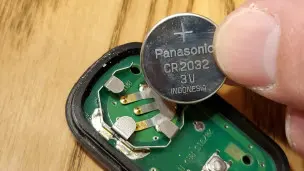
To replace the batteries on your opener remote:
- Access the batteries by opening the back panel of your remote.
- Observe the battery type and size, and get a replacement unit.
- Take the batteries out.
- Check the battery contacts. They may need replacement if worn out, dirty, or wet.
- Replace the dead batteries by slipping in fresh batteries. Depending on your remote or keypad, they can be small, round, AA, or AAA batteries.
- Screw drive the garage door remote cover back.
- Test to confirm.
Is The GFCI System Working?
Another common cause for your garage door remote control not functioning is a blown Ground Fault Circuit Interpreter (GFCI). A GFCI protects your home from potential electrical dangers, such as overheating.
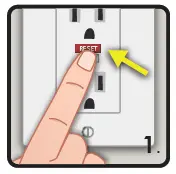
Suppose you’ve ever been using your hairdryer and caused a surge. In this case, your GFCI may have jumped to prevent you from blowing a fuse.
A malfunctioning GFCI would generally stop the door from functioning when it comes to your garage door.
You can fix a jumped GFCI by resetting the button on the wall outlet that links to your garage door—usually in the garage, laundry room, or main bathroom.
Are The Codes Desynchronized?
Chances are frequent use may have caused the remote and the motor to desynchronize. This may happen, although it is not a typical case.
To reprogram your garage door remote:
- Look for the yellow learn button on your garage door motor.
- Press and then release the learn button. The indicator light should come on and remain lit.
- Within 30 seconds, grab your remote and press and hold the button.
- After several seconds, the indicator light on the garage door motor should flash. That means the resynchronization has worked.
- Test the remote to ensure everything works.
You could also reset the motor and the remote. This may be possible if your remote and motor assembly have a reset button.
Are There Problems With Your Garage Door Installation?
Suppose the remote and door do not open after all the troubleshooting processes above. In that case, you may have a problem with your garage door system’s installation.
This is a whole new can of worms, as the failure could be with control wiring, motor, logic board, or the opener’s receiver board.
This may be possible with a new installation or old garage doors that have aged and have faults here and there. If this is the case, call to have your garage door services provider inspect and repair the system.
Are Your Garage Door Parts Wearing Out?
This may be more likely if you have old garage door opener systems. A garage door opener does contain many extra components. Some of these parts may wear out over time. If they are broken, they may cause your door to not open.
Some of the common issues may include:
Door Springs: Depending on the setup, your garage door may use torsion springs or extension springs. These torsion bar springs may deteriorate over time, losing their elasticity. This gradually adds more load to the motor, which may cause the door to not open.
Rubber Belt: Some garage door opener motors have rubber belts in their system. Over time, these rubber belts deteriorate, losing elasticity and being unable to pull the garage door up well.
Antenna Wire: If your garage door opener’s antenna wire stops working, it cannot pick up signals. It may also be more vulnerable to picking up additional interference issues.
Chain Drive: The chain drive helps to pull the garage door open. It is quite common in residential garages. Since this is a moving part, it may wear out rather quickly. Your garage door may also be using direct drive openers or belt drive openers.
Read all about different types of garage door openers here.
Electric Motor: The electric motor turns electricity into kinetic energy to move the drive chains. They may also wear out from years of use.
It may make sense to have a garage door technician check these ancillary components to determine if your garage door problem is indeed from your remote.
If there are issues, these garage door professionals should be able to perform the repairs for you. Garage door repair costs can range widely, so call several garage door repair professionals for quotes before proceeding.
